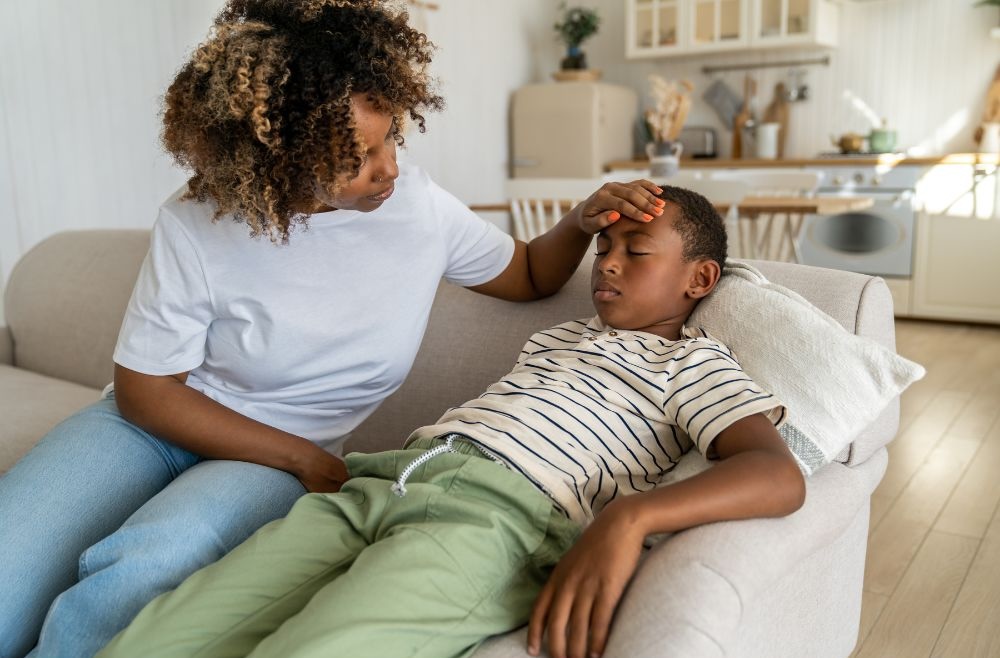Dealing with anxiety can be challenging for anyone, and it can be particularly difficult for children who may not have the tools to express or cope with their emotions. It’s also challenging as a mom to witness and support a child who is struggling with anxiety, too.
How To Help Your Anxious Child
As a mom, it’s important to know how to help your anxious child in a way that is supportive and effective. In this blog post, I share five do’s and five don’ts to help your child manage their anxiety.
5 Do’s To Help Your Anxious Child
1. Validate their feelings
The first thing you can do to help your anxious child is to validate their feelings. It’s essential to let your child know that it’s okay to feel anxious and that you understand their worries. By doing this, you are creating a safe space for your child to express their emotions without fear of judgment. When you validate your child’s feelings, they will feel heard, understood, and supported.
To validate your child’s feelings, you can say things like “I understand how you feel” or “It’s okay to be anxious.” Letting your child know that you are there to support them and that you understand their feelings will go a long way in helping them manage their anxiety.
Resources:
- Feel Your Feelings (podcast)
- Teaching Kids About Thoughts And Feelings (podcast)
2. Listen actively
Listening actively is another important step in helping your anxious child. When your child expresses their worries, it’s essential to listen with an open mind and show empathy. Avoid interrupting them, and try to understand their perspective. Active listening involves paying attention to your child’s words, tone of voice, and body language.
When you listen actively, you are not only showing your child that you care, but you are also gaining a better understanding of their anxiety. By doing this, you can help your child identify the root cause of their anxiety, which can make it easier to find solutions.
3. Teach relaxation techniques
Teaching relaxation techniques is another effective way to help your anxious child. Breathing exercises, meditation, or other relaxation techniques can help your child calm down when they feel anxious. Practicing these techniques regularly can also help your child manage their anxiety in the long run.
One of the simplest breathing techniques you can teach your child is called belly breathing. To do this, have your child lie down and place their hand on their stomach. Ask them to take a slow, deep breath in through their nose, feeling their stomach rise, and then slowly exhale through their mouth, feeling their stomach fall. Repeat this process for several minutes, focusing on the breath and letting go of any worries.
4. Encourage positive thinking
Encouraging positive thinking is another way to help your anxious child. It’s essential to help your child reframe negative thoughts into positive ones and encourage them to focus on the positive aspects of a situation. When your child has a negative thought, you can help them turn it around by asking them to find evidence that contradicts it. This can help them see things from a different perspective and reduce their anxiety.
For example, if your child is worried about starting a new school, you can help them reframe their thoughts by asking them to focus on the positive aspects of the situation. You can say things like “Think of all the new friends you’ll make” or “You’ll have the opportunity to learn new things.” By encouraging positive thinking, you are helping your child build resilience and cope with their anxiety in a healthy way.
Resources:
- Positive Thinking: 21 Affirmations To Tell Your Kids Today (blog post)
- How To Cope With Negative Thoughts As A Mom (free class)
5. Seek professional help
If your child’s anxiety is interfering with their daily life, it’s essential to seek the help of a mental health professional. A qualified therapist can work with your child to develop coping strategies and provide tools to manage their anxiety. Therapy can also help your child identify the root cause of their anxiety and work through any underlying issues.
It’s important to remember that seeking professional help is not a sign of weakness.
5 Don’ts To Help Your Anxious Child
1. Don’t dismiss their feelings
While it’s important to encourage your child to see things in a positive light, it’s equally essential not to dismiss their feelings. Telling your child to “just relax” or “stop worrying” can make them feel invalidated and more anxious. It’s important to acknowledge that their feelings are real and that it’s okay to feel anxious.
When your child expresses their worries, try to avoid phrases like “Don’t be silly” or “It’s not a big deal.” Instead, acknowledge their feelings by saying things like “I can see that you’re really worried about this.” By doing this, you are validating their feelings and letting them know that you take their concerns seriously.
2. Don’t avoid triggers
While it may be tempting to avoid situations that make your child anxious, it’s important to help them confront their fears in a safe and controlled manner. Avoiding triggers can reinforce your child’s anxiety and make it more difficult for them to cope with their fears in the long run.
Instead of avoiding triggers, try to help your child face their fears in a gradual and supportive way. For example, if your child is afraid of dogs, you can start by showing them pictures of dogs and gradually work up to meeting a friendly dog on a leash. By doing this, you are helping your child build resilience and confidence in their ability to manage their anxiety.
3. Don’t label your child
Avoid labeling your child as “an anxious child” or using anxiety as their defining characteristic. While it’s important to acknowledge that your child is experiencing anxiety, it’s equally essential not to define them by their anxiety. By labeling your child, you are limiting their potential and reinforcing negative beliefs about themselves.
Instead, focus on your child’s strengths and positive qualities. Encourage them to pursue their interests and hobbies, and remind them that their anxiety does not define them.
4. Don’t pressure them
Putting pressure on your child to overcome their anxiety can make them feel more stressed and overwhelmed. It’s important to remember that managing anxiety is a process, and it takes time and patience.
Instead of pressuring your child, focus on supporting them and providing them with the tools they need to manage their anxiety. Celebrate small victories, and remind them that progress takes time.
5. Don’t compare your child to others
Comparing your child’s anxiety to other children’s behavior can make them feel inadequate or ashamed of their anxiety. Every child is different, and each child’s experience of anxiety is unique.
Instead of comparing your child to others, focus on their individual strengths and challenges. Celebrate their progress, and remind them that everyone has their own struggles to overcome.
Additional Resources:
- Mindfulness Techniques For Anxious Moms (blog post)
- How To Use Mindfulness TO Reduce Stress And Anxiety (blog post)
- How To Stop Worrying (podcast)
- Anxiety In Motherhood (podcast)
A Final Note
Dealing with anxiety can be challenging for both children and parents, but by following these do’s and don’ts, you can help your child manage their anxiety in a healthy and effective way. Remember to validate their feelings, listen actively, teach relaxation techniques, encourage positive thinking, seek professional help if needed, avoid dismissing their feelings, avoid triggers, avoid labeling them, avoid pressuring them, and avoid comparing them to others. With your support, your child can learn to manage their anxiety and thrive.



